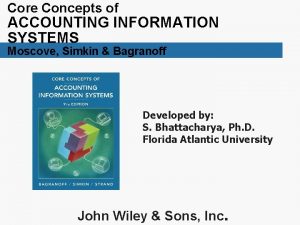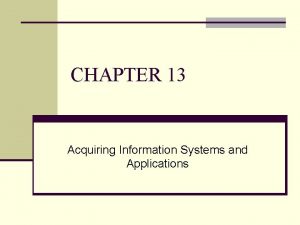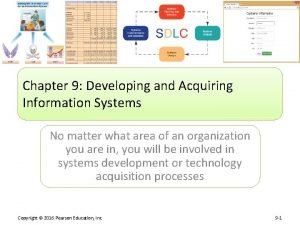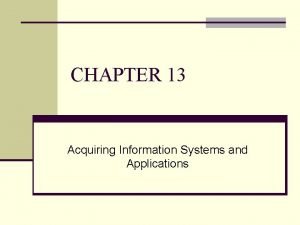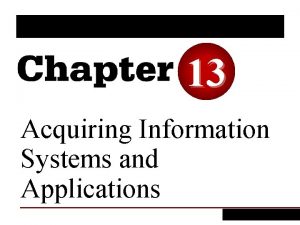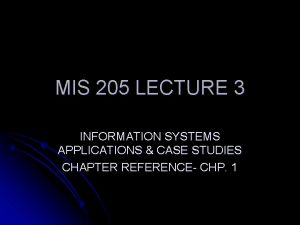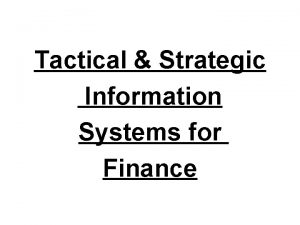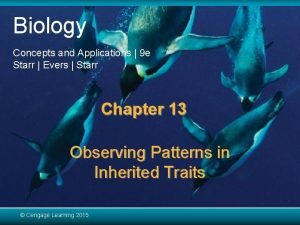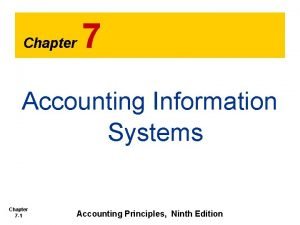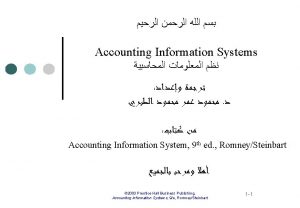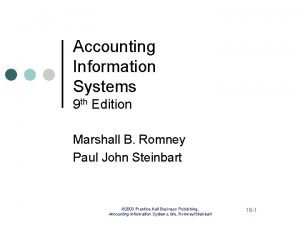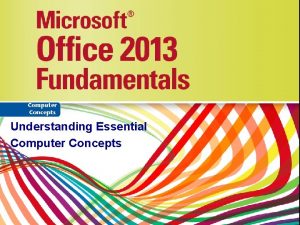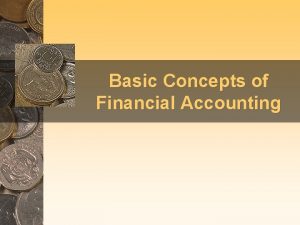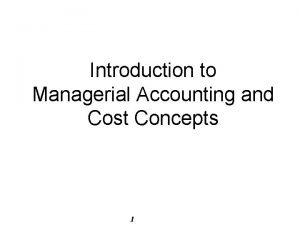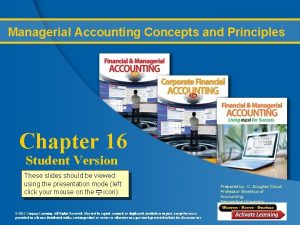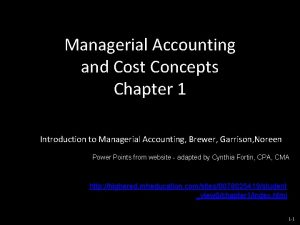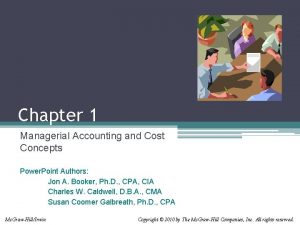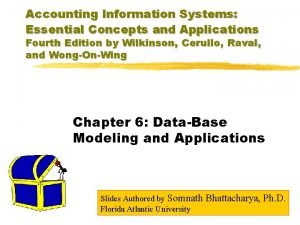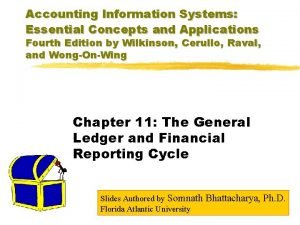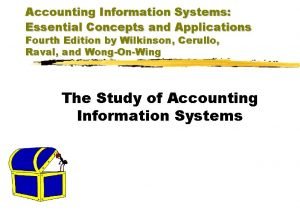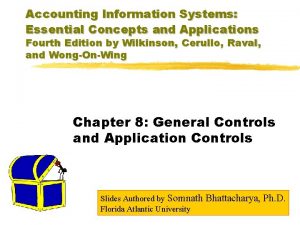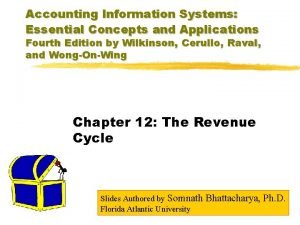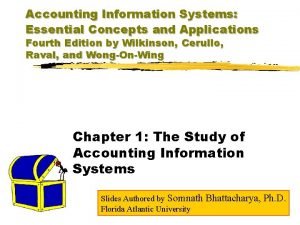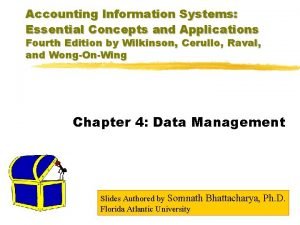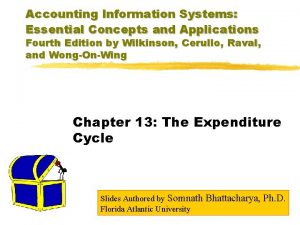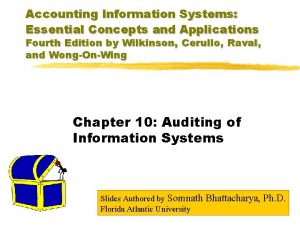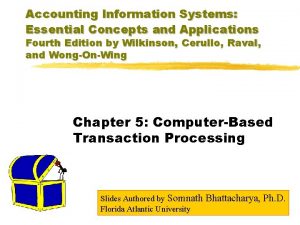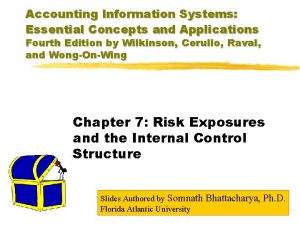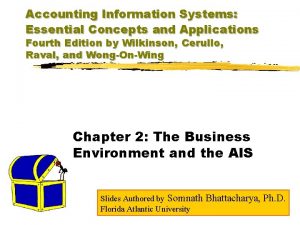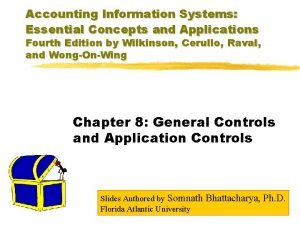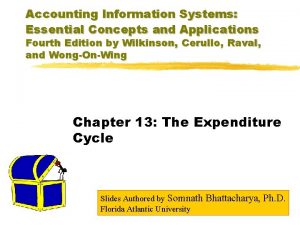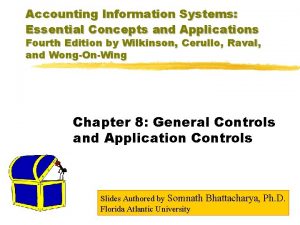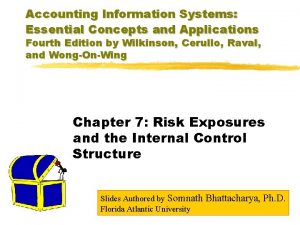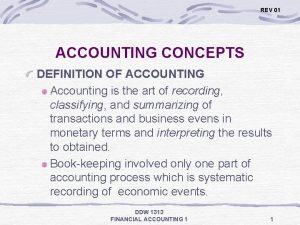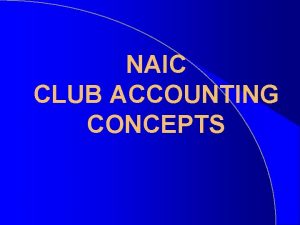Accounting Information Systems Essential Concepts and Applications Fourth





























- Slides: 29

Accounting Information Systems: Essential Concepts and Applications Fourth Edition by Wilkinson, Cerullo, Raval, and Wong-On-Wing Chapter 3: AIS Enhancements Through Information Technology and Networks Slides Authored by Somnath Florida Atlantic University Bhattacharya, Ph. D.

Importance of IT and Computer Networks to Accountants z. To use, evaluate, and develop a modern AIS, accountants must be familiar with IT z. Computers enable accountants to perform their duties more quickly, accurately, and consistently than by manual methods z. Software such as electronic spreadsheets aid accountants in analyzing financial statements and in developing budgets

IT Components of Interest to Accountants z. Devices for data entry z. Data Processing z. Data Communication z. Information Generation z. Data Bases z. Data Modeling concepts z. Evaluation of internal controls in AIS z. Variety of software packages z. Computer Networks

Networks & Accountants z Because they transmit data and information, networks are an integral part of AIS z Networks are vulnerable to high level risk thus requiring special controls and security measures. y. Need to prevent loss of accounting records & information y. Need to ensure accuracy of data z Networks may be used to consolidate data into financial information

Gains from IT for Accountants z Faster processing of transactions and other data z Greater accuracy in computations of and comparisons with data z Lower cost of processing each transaction z More timely preparation of reports and other outputs z More concise storage of data, with greater accessibility when needed z Wider range of choices for entering data and providing outputs z Higher productivity for employees and managers, who learn to use computers effectively in their routine and decision-making responsibilities

Task Matching to Computers z Manual z Exceptional/infrequent transactions z Setting objectives and policymaking judgments z New problems z Supervising employees z Social communications z Making complex strategic decisions Figure 3 -1 z Computerized z Collecting and processing large volumes of routine transactions z Storing large quantities of data and information z Monitoring and controlling continuous processes z Answering specific inquiries based on stored data z Preparing complex analyses and extensive reports z Helping gather data and understanding the relationships between all types of decisions

Limitations of Infoage’s Legacy AIS z Large portion of personnel time and effort spent on systems maintenance y Little time & effort for value-added services y Little flexibility to changing business conditions z Financial and Operational data not integrated y Difficult to generate data with both financial and non-financial components z The transaction processing systems focus on chart of accounts classification x. Ignore the multidimensional aspects of transactions x. Files related to applications are not integrated z Inefficiencies of the manual system remodeled in automated form x. Business processes and accounting procedures not analyzed and improved upon prior to conversion to automated form z System not geared to generate timely decisionsupport information x. Computer programmers required to write new programs for ad hoc queries

Types of Network Architectures z. Wide-Area Networks y. Formed among computers and interconnected devices that are geographically distant from one another z. Local-Area Networks y. A type of distributed network created when two or more linked computers are grouped within a limited geographical area

Centralized WANs - I z Concentrates all application processing at one geographical location z Consists essentially of one (or a cluster of) central mainframe computer(s) and one or more physically remote terminals z Typically all hardware, software, and data processing personnel are located at corporate headquarters z Advantages include: y the concentrated computing power of a large processor y low operating costs per transaction leading to economies of scale y can facilitate the use of a database approach y facilitate better security provisions y allow for greater standardization and professional planning and control of information-related activities

Centralized WANs - II z Best suited for y Firms with centralized organizational structures y Firms with homogeneous operations y Firms with low processing activity at remote sites z Examples include y Savings and loan institutions y Banks with many ATMs and branches y Merchandizing chains y Motels y Airlines z Drawbacks include y Inflexibility y Expensive and complicated software needed y Vulnerable to disasters as a result of complete dependence on central computer y Not user-friendly

Distributed WANs - I z This links fully functional computers in different geographical locations. z Each remote site processes its own applications. However, users may not have easy access to centralized data or be able to transmit data and information rapidly. z Computers may be interconnected by data communications hardware and software to other remote sites and to a central computer facility to form an “enterprise-wide” network.

Distributed WANs - II z Distributed databases are useful when: y Large volumes of data need to be processed at remote locations y Managers and employees need very fast access to data on a frequent basis z Databases may be distributed by replication or partition. y Replication: Copies of files from the main data base are stored at remote locations y Partition: Segments of files are allocated to various locations within the network x. This avoids data redundancy, but increases the complexity of transmitting data throughout the network x. Likely to become the dominant approach as technology improves y At present most data bases are a hybrid of the two approaches

Benefits of Distributed WANs z Can be responsive to diverse needs of users z Enable network facilities to be used efficiently since processing jobs can be routed to unused computer systems in the network z Are robust against individual computer failures z Flexible and adaptable to change z Best suited for firms with: y Decentralized organizational structures y Diverse operations or user groups y Clustered functions at various locations y Multiple products y Manufacturing operations y A variety of services

Drawbacks of Distributed WANs z Difficulty in maintaining adequate control and security y. Each distributed processing location needs its own set of controls and security measures z Given the smallness of each location, organizational independence is not easily achieved z Managers may sacrifice control and security for greater productivity z Difficulty and cost of coordinating the relatively independent and sometimes incompatible computer systems y. Added costs for multiple computers, other system components, and communication services

LANs z. A LAN may be connected to other LANs and/or WANs via hardware devices known as gateways or bridges z. At the heart of a LAN is the workstation y. Microcomputer-based workstation y. Traditional workstation y. Super workstation

Peer-to-Peer LANs y. In smaller LANs, every workstation functions as both a client and a server y. This allows all users to share data and files on all workstations y. Called peer-to-peer network since no workstations are dedicated to perform only server functions y. Compared to a server network, peer-to-peer networks are less costly, easier to install, and compare well against server networks of similar size y. Number expected to significantly increase in the near future

Server Networks z May interconnect hundreds of workstations z More difficult to manage and interpret than peer-to-peer networks z Provide greater security than peer-to-peer networks z At least one workstation is dedicated to performing specific server tasks z Examples include: y Servers y Database servers y Print servers y Communications servers y Transaction processing servers z Large server networks often contain multiple servers

The Network Operating System z In peer-to-peer networks, the Network Operating Software (NOS) is installed in each user workstation z In a server network, most of the NOS is installed in the file server and a portion also resides in each workstation z To run centralized LAN applications, the NOS installed in the file server interacts with the NOS and the local operating system installed in the workstation. The client workstation NOS initiates a request to the file server NOS to load files and programs into the client workstation’s RAM z In a peer-to-peer network, a client NOS initiates a request to another client NOS, which also functions as a server, to load the requested files and/or programs into RAM

More Networks z Examples of pre-developed network configurations resident in Network Interface Cards include: Ethernet, Token Ring, and ARCnet z The International Standards Organization has issued the Open Systems Interconnection (OSI) model y. Open Systems Architecture y. Seamless exchange of data, files, and software between LANs and WANs built with multiple vendors’ hardware, software, and networking components

Client/Server Networks z. This model splits data processing between a user workstation (client) and one or more servers z. Majority of servers are dedicated database servers, thereby enabling client to share data and files, conduct database searches, and update the database z. One of the fastest growing segments of IT

Cooperative Client/ Server Computing z. Most commonly implemented mode of client/server architecture z. Facilitates the optimal sharing of computer resources since the client(s) and server(s) jointly process the data z. Clients typically employ Graphical User Interfaces (GUIs) z. Data-processing locale is transparent to the user

Network Topologies z. The STAR and RING topologies apply to both distributed WANs and LANs z. The BUS topology applies only to LANs z. All three found in client/server networks z. All three may be combined to form hybrid configurations

The STAR Configuration Figure 3 -3 a

The RING Configuration Figure 3 -3 b

The BUS Configuration Figure 3 -3 c

Enterprise-wide Processing and Data Systems z Enterprise-wide on-line transaction processing systems collect and process mission-critical accounting and operational applications z Enterprise Resource Planning Systems (ERP) such as SAP R/3 overcome the limitations of legacy applications z Firms typically develop two types of On-line Analytical Processing (OLAP) systems that supplement ERP or legacy systems y A firm can model the relevant aspects of business events contained within the business processes allowing for the use of relational database-related query language commands y Firms can create a data mart or data warehouse to generate predefined reports for executives and other managers

Data Marts and Data Warehouses z Both Data Marts and Data Warehouses organize and store copies of “informational” or decision support data z A Data Mart stores copies of decision support data in a data base for a portion of a company z A Data Warehouse stores copies of decision support data in an integrated data base for an entire enterprise z As opposed to applications-oriented data in legacy systems, data in a data mart or warehouse are stored by subject areas (e. g. , customers) z Data may be stored in both summarized or “raw” form z Both have “drill down” and “data mining” features

Specialized Inter-organizational Systems/Networks z Internet Commerce and Electronic Commerce z Point-of-Sale Systems/Networks z Electronic Funds Transfer (EFT) Systems z Electronic Data Interchange (EDI) Systems y. Value Added Networks (VANs) z The Internet (TCP/IP) y. The World Wide Web (WWW) x. Hypertext information retrieval system z Intranets z Extranets

Accounting Information Systems: Essential Concepts and Applications Fourth Edition by Wilkinson, Cerullo, Raval, and Wong-On-Wing Copyright © 2000 John Wiley & Sons, Inc. All rights reserved. Reproduction or translation of this work beyond that permitted in Section 117 of the 1976 United States Copyright Act without the express written permission of the copyright owner is unlawful. Request for further information should be addressed to the Permissions Department, John Wiley & Sons, Inc. The purchaser may make back-up copies for his/her own use only and not for distribution or resale. The publisher assumes no responsibility for errors, omissions, or damages, caused by the use of these programs or from the use of the information contained herein.
 Core concepts of accounting information systems
Core concepts of accounting information systems Methods of acquiring information system
Methods of acquiring information system Developing and acquiring information systems
Developing and acquiring information systems Acquiring information systems and applications
Acquiring information systems and applications Acquiring information systems and applications
Acquiring information systems and applications Discrete math susanna epp
Discrete math susanna epp Expert systems: principles and programming, fourth edition
Expert systems: principles and programming, fourth edition Information systems applications
Information systems applications Tactical information systems
Tactical information systems Human genetics concepts and applications 10th edition
Human genetics concepts and applications 10th edition Starr evers starr biology concepts and applications
Starr evers starr biology concepts and applications Essential non essential fatty acids
Essential non essential fatty acids Chapter 7 accounting information systems
Chapter 7 accounting information systems Chapter 7 accounting information systems
Chapter 7 accounting information systems Introduction to accounting information system
Introduction to accounting information system Slidetodoc.com
Slidetodoc.com Chapter 7 accounting information systems
Chapter 7 accounting information systems Accounting information systems marshall b romney
Accounting information systems marshall b romney Ethics in information technology fourth edition
Ethics in information technology fourth edition Ethics in information technology fourth edition
Ethics in information technology fourth edition Understanding essential computer concepts
Understanding essential computer concepts Motivation from concept to application
Motivation from concept to application Basic concepts of accounting and finance
Basic concepts of accounting and finance What do you mean by accounting convention
What do you mean by accounting convention Part one—analyzing accounting concepts and procedures
Part one—analyzing accounting concepts and procedures Managerial accounting and cost concepts
Managerial accounting and cost concepts Accounting principles and policies
Accounting principles and policies Managerial accounting concepts and principles
Managerial accounting concepts and principles Chapter 1 managerial accounting and cost concepts
Chapter 1 managerial accounting and cost concepts Chapter 1 managerial accounting and cost concepts
Chapter 1 managerial accounting and cost concepts
